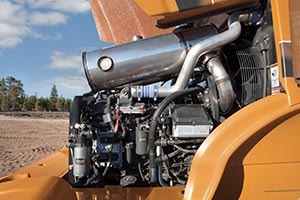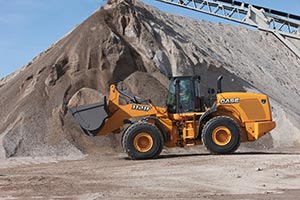A case for SCR
As the industry shifts from Tier 4 Interim to Tier 4 Final, producers have decisions to make between SCR and EGR machines.
Tier 4 mandates are a hot topic of conversation everywhere, from equipment dealer halls to quarries and loading yards. There’s a lot of information to digest, but it’s important to know that, based on equipment type and style, there are different Tier 4 solutions for different machines.

It’s important to know that, based on equipment type and style, there are different Tier 4 solutions for different machines.
Most construction equipment manufacturers have focused on two options for Tier 4 Final solutions on heavy equipment. Both involve an exhaust treatment system. One is selective catalytic reduction (SCR). The other is cooled exhaust gas recirculation (EGR). Both reduce particulate matter and nitrogen oxides (NOx) emissions in keeping with Environmental Protection Agency (EPA) mandates. NOx is produced when the engine is at its hottest. Particulate matter is created when fuel is not burned during combustion – usually when the engine is cooler.
SCR reduces the formation of particulate matter in the combustion chamber and treats exhaust gases with diesel exhaust fluid (DEF) to eliminate pollutants. An engine that uses an SCR system is tuned for maximum efficiency. The higher combustion temperatures involved reduce particulate matter levels but increase NOx levels.
To address high NOx levels, the after-treatment-only system creates a chemical reaction by adding DEF. This transforms NOx into nitrogen and water, which occurs naturally in the atmosphere.
With a cooled EGR system, exhaust gases are cooled, blended with fresh air and returned to the engine. The process lowers combustion temperatures and dramatically reduces NOx. The cooler combustion temperature results in a higher particulate matter level, which is then reduced through the use of an after-treatment diesel particulate filter (DPF).
There are advantages to both SCR and CEGR, yet the benefits of one solution can outweigh the other based on the application of the machine – and how it affects overall productivity and profitability.
Application-specific demands
Most often, wheel loaders load trucks at the quarry face, feed a crusher or hopper, or load trucks in a loading yard. Wheel loaders also spend a considerable amount of time stockpiling materials. Machines can be equipped with a number of attachments that make moving material from one point to another quicker and more efficient.
A wheel loader, by its nature, produces inconsistent engine loads. In a common loading Y-cycle, for example, operators accelerate just after putting the wheel loader into a forward gear toward the pile. Then, operators decelerate just before reaching the pile. Operators then throttle up again to penetrate the pile and throttle back to complete the bucket fill. Later, operators put the machine in reverse and accelerate backward before decelerating prior to making a full stop.
At that point, operators adjust the bucket height, put the machine in forward and accelerate to reach the truck or hopper. Then, they decelerate again as it reaches that point. Again, operators throttle up to lift the load to the desired height and empty the bucket. Passes are kept short in order to conserve fuel and save time. Loaders may then idle as operators wait for the next truck to come into the loading zone.
This sequence is very similar in action to hopper loading, in which operators may also find themselves idling as they wait for the hopper load to process through before they can dump the next bucket.
Selective catalytic reduction
The tasks performed and machine-operating characteristics help illustrate why SCR technology is well suited for wheel loaders. Based on the work performed, wheel loaders must generate power at varied engine outputs and speeds.
Because SCR is an after-treatment system and works separately from the engine, it lets the machine maintain horsepower and doesn’t sacrifice breakout force. It can actually improve overall performance because the engine breathes more freely than a machine that uses cooled EGR technology. The technology also doesn’t require the use of regeneration to burn off accumulated particulate for faster throttle response time, which takes on added importance in a heavy-loading operation.
Another factor that comes into play is combustion temperatures. Cooled EGR technology is highly effective in certain applications, but the technology is best suited when conditions call for consistent combustion temperatures – as found in excavators. Steady temperatures allow a portion of the exhaust gases to be cooled relatively easily, blended with fresh air and circulated back into the combustion chamber to lower combustion temperature, which in turn, reduces NOx. Given the operating characteristics and varied engine loads, wheel loaders typically do not generate the consistent combustion temperatures required for an effective cooled EGR solution.
Wheel loader idling is yet another important consideration, as it lowers combustion temperatures. The lower temperatures ultimately result in higher particulate matter levels. The higher levels can be readily addressed with the DPF on a cooled EGR system, but that ultimately leads to more frequent regeneration of the DPF.
More frequent regeneration can also inhibit production and increase maintenance costs. SCR technology eliminates regeneration and the associated downtime and hassle.
Design simplicity lowers long-term costs
Many decision-makers also appreciate the design simplicity of an SCR system, which doesn’t require a DPF for lower long-term maintenance costs. An SCR system only requires periodically filling the DEF tank and does not involve any special fuel. A warning light signals when the DEF is running low. Refilling the DEF tank can be done as part of regular maintenance when checking fluid levels, or when refueling.
Filters in the DEF circuit are usually easy to access and have a maintenance schedule equal to engine oil. Additionally, SCR-equipped wheel loaders will continue to use standard oils without any concern for switching to low-ash oils or other more expensive formulations. DEF, which is only needed in small amounts, is also easy to find. SCR engines do not require any special fuel.
As the industry transitions from Tier 4 Interim to Tier 4 Final, it can expect to see more wheel loader manufacturers transition to SCR as a solution for machines. Based on the workload and machine engineering, SCR makes sense. Preconceptions about SCR and the hassles of adding DEF will fade away as regeneration becomes a thing of the past, as fuel efficiency improves and as wheel loaders perform with strength and without hesitation.
Brad Stemper is solutions marketing manager for Case Construction Equipment.
Take Note
Selective catalytic reduction systems do not require a diesel particulate filter to lower long-term maintenance costs. Instead, they require a periodic filling of the diesel exhaust fluid tank. And they do not require any special fuel.
(Photos courtesy of Case Construction Equipment)











